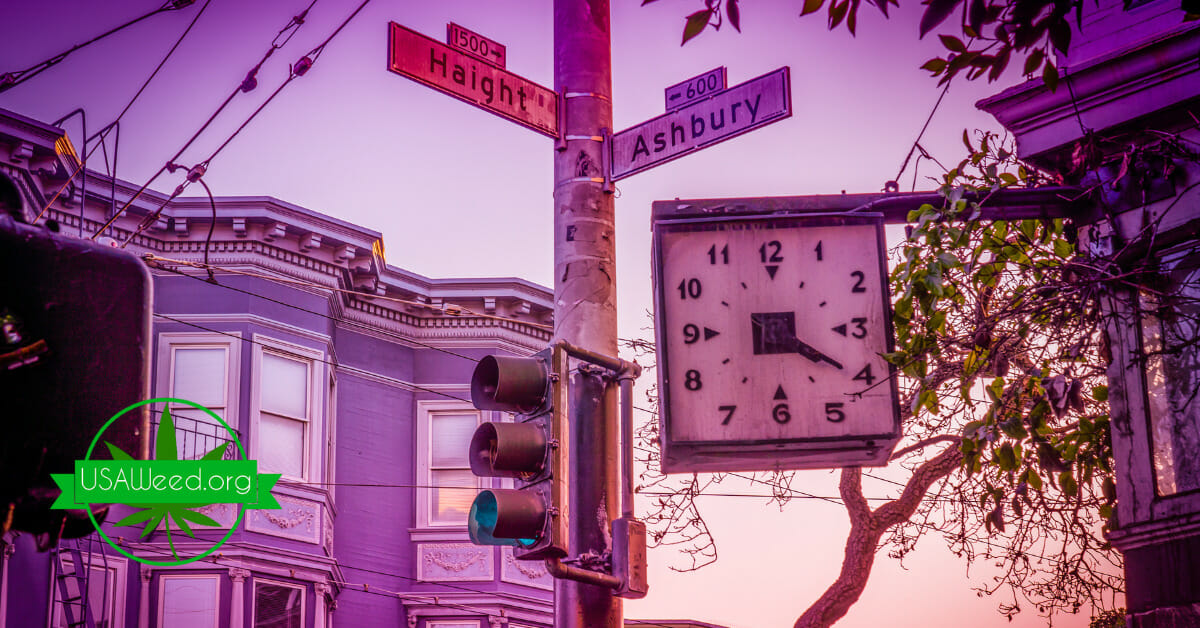Past and Present – Historic Haight-Ashbury
Ah, San Francisco! A city of diverse cultures, tech innovations, and steep hills. But when it comes to the historic Haight-Ashbury district, there’s a particular green leaf that stands out. Yes, we’re talking about cannabis. Haight-Ashbury isn’t just a district; it’s a symbol of a revolution, and its ties to cannabis are legendary. Let’s journey through the lanes of history and discover the legacy of cannabis in this iconic neighborhood.

History of Haight-Ashbury
Nestled at the crossroads of Haight and Ashbury streets in San Francisco, the Haight-Ashbury district is a fusion of history, culture, and revolution. Born from the early 20th-century urban developments, the district initially thrived as a refuge for the city’s middle class. Graceful Victorian homes dotted the landscape, a testament to the area’s early affluence.
However, it was during the tumultuous 1960s that Haight-Ashbury truly found its identity. As the civil rights movement, anti-Vietnam War protests, and demands for free speech engulfed the nation, Haight-Ashbury emerged as the epicenter of the counterculture movement. Young adults, disillusioned by the societal norms and eager to challenge the status quo, flocked to this district. Drawn by its affordable rents and the promise of a community that embraced alternative lifestyles, they soon turned Haight-Ashbury into a hotbed of artistic expression, political activism, and, of course, free love.

The Summer of Love in 1967 further cemented Haight-Ashbury’s reputation. Thousands of young people, or “hippies” as they were popularly known, converged on the district, creating a melting pot of ideas, music, and cultural exchange. Iconic artists like Jimi Hendrix, Jefferson Airplane, and The Grateful Dead either lived in or frequented the district, adding to its legendary status. Psychedelic rock tunes filled the air, colorful murals adorned the walls, and the scent of incense (and occasionally cannabis) wafted through the streets.
But as with all things, change was inevitable. By the 1970s, the district began to grapple with the challenges of drugs and homelessness. The utopian dreams of the 60s faced the harsh realities of urban decay. Yet, through all its ups and downs, Haight-Ashbury never lost its soul.
Cannabis and Haight-Ashbury
It’s hard to imagine Haight-Ashbury without the scent of cannabis wafting through its streets. As the counterculture movement gained momentum, cannabis became its unofficial emblem. Legends like Janis Joplin and the Grateful Dead, who frequented the district, were open cannabis enthusiasts. It wasn’t just about getting high; it was a symbol of resistance, peace, and a departure from conventional societal norms. Cafes, lounges, and street corners became places of exchange – not just for cannabis but for ideas, dreams, and the promise of a freer world.
Modern Day Haight & Ashbury
Fast forward to today, and Haight-Ashbury still retains its rebellious charm. Though the world of cannabis has evolved, with dispensaries, edibles, and CBD therapies, the district remains a homage to its green legacy. Trendy cannabis cafes stand alongside historic murals, and every corner tells a story. The district, in many ways, has shaped the narrative of cannabis legalization and its integration into mainstream culture.

Today’s Haight-Ashbury is a vibrant blend of its storied past and the contemporary cannabis culture. The district, once the heartland of the ’60s counterculture movement, has gracefully evolved, embracing the modern facets of the cannabis industry. Trendy cannabis boutiques and dispensaries dot the streets, offering a wide range of products from medicinal CBD oils to artisanal edibles.
But it’s not just about commerce. The community in Haight-Ashbury remains deeply connected to the ethos of cannabis as a symbol of freedom and expression. The district often hosts cannabis-related events, workshops, and festivals, celebrating the plant’s journey from a rebel symbol to mainstream acceptance. Street artists continue to paint vivid murals that echo the district’s rich history while infusing modern cannabis motifs.
Moreover, the conversations have matured. Residents and visitors alike engage in dialogues about the benefits of cannabis, its ethical cultivation, and the future of its legalization. The district has become a hub for cannabis education, with many establishments offering courses on responsible consumption and the science behind the plant.
In essence, while the Haight-Ashbury of today pays homage to its vibrant past, it looks forward with optimism, embodying the ever-evolving narrative of cannabis in modern society.
A Legacy That Continues to Blaze
Haight-Ashbury’s alleys echo with tales of revolution, freedom, and a plant that became a symbol of change. From the Summer of Love to the present day, the district’s cannabis legacy is a testament to the enduring spirit of rebellion and the quest for liberty. And as the fog rolls over San Francisco, one can almost hear the whispers of the past, beckoning us to keep the flame alive.
Show Your Love for the Green Legacy
Hey there, fellow cannabis enthusiast! Do you feel the vibes of Haight-Ashbury calling out? Help us at USAWeed.org keep the spirit of the cannabis movement alive. By joining our Coffee Brigade at https://www.patreon.com/USAWeed, you’re not just supporting us; you’re ensuring the stories, histories, and legacies of places like Haight-Ashbury continue to be shared. Every sip of coffee you fund helps us delve deeper, share wider, and celebrate the world of cannabis. So, ready to brew some magic?



